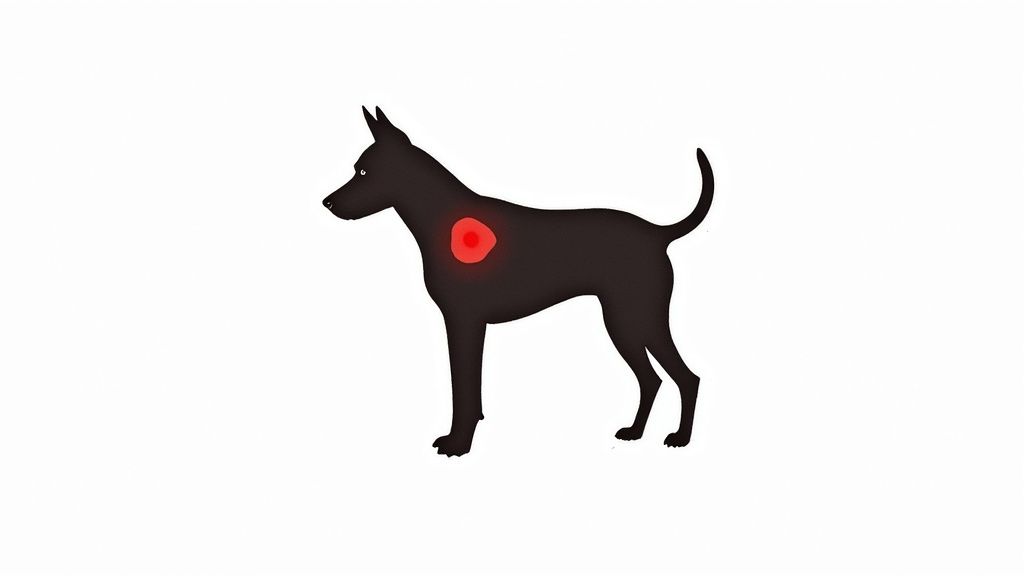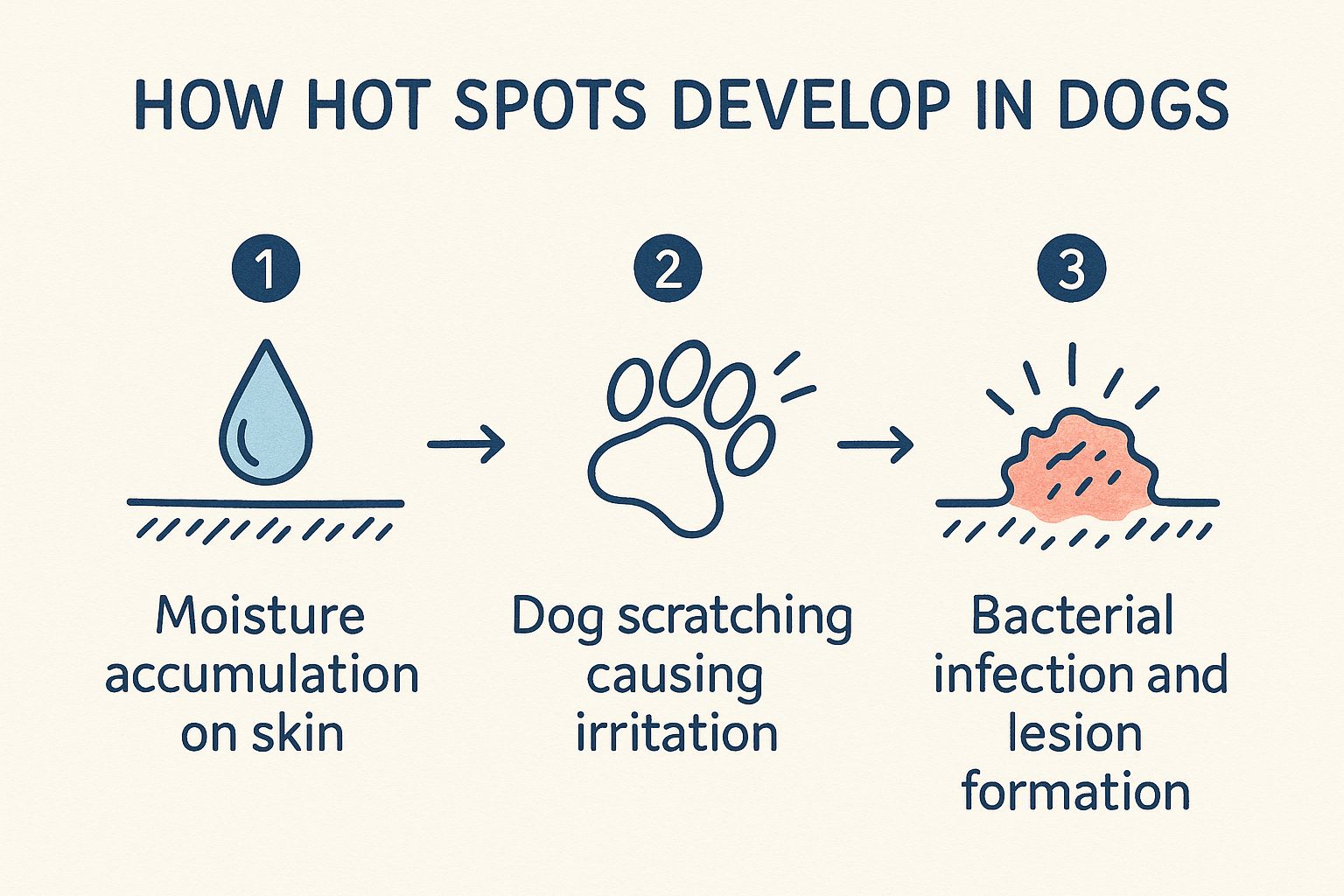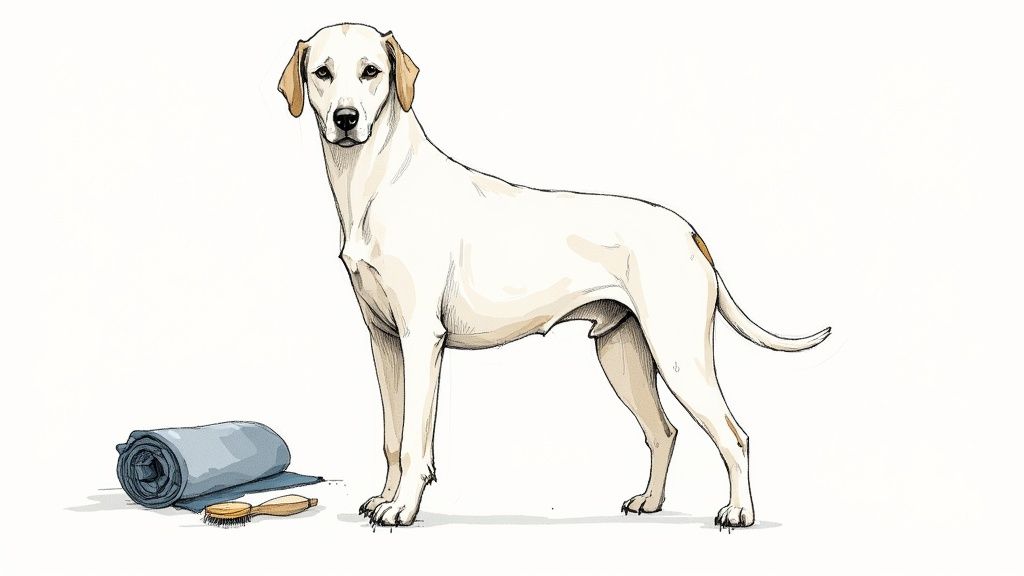You know that angry, red patch of skin that seems to pop up on your dog out of nowhere? That's a hot spot, and it’s a sure-fire sign that something else is going on. These sore-looking lesions, officially known as acute moist dermatitis, are basically your dog's skin having an extreme reaction to an irritant. Figuring out that root cause is your first job in getting them sorted.
Uncovering the Triggers Behind Hot Spots

It helps to think of a hot spot not as the actual problem, but as the result of one. Your dog feels an itch, a sting, or even a deep ache and starts licking, chewing, or scratching to get some relief. It's this non-stop worrying at the area that breaks the skin.
Once that happens, you’ve got a warm, damp environment that’s a perfect home for bacteria. This quickly spirals into a nasty, painful infection that can spread alarmingly fast. The real secret to successful treatment is finding out what kicked off the irritation in the first place.
Common Culprits of Canine Hot Spots
A few usual suspects are often behind this frustrating cycle. An insect bite, especially from a flea, is a classic trigger for dogs with sensitive skin. For some, just one bite is enough to set off an intense allergic reaction.
Moisture is another huge factor. If your dog is a keen swimmer or just gets soaked on a rainy walk, any water trapped under their coat creates an ideal breeding ground for bacteria. This is a big reason why thick-coated breeds like Golden Retrievers and German Shepherds are so often affected.
But sometimes, the cause is a bit deeper. Common instigators include:
- Allergies: Whether it’s something in the environment or their food, the constant itch from an allergy leads to scratching that damages the skin barrier. For more on this, have a look at our guide on why your dog is scratching and how to help naturally.
- Hidden Pain: A dog suffering from arthritis might lick at a sore joint for comfort, while an ear infection can cause frantic scratching around their head and neck.
- Stress or Boredom: Licking can become a compulsive habit for anxious dogs or those who aren't getting enough mental stimulation.
With so many dogs sharing our homes, understanding these common problems has never been more vital. A recent UK dog population study found there are now around 13 million pet dogs in the country – a much higher figure than anyone thought. This just goes to show how many owners could benefit from being able to spot and manage issues like hot spots. You can discover more insights from this UK dog population study and what it means for our furry companions.
Getting Started with At-Home Hot Spot Treatment
Finding a red, angry hot spot on your dog is always worrying. But don’t panic—acting quickly at home can make a world of difference, offering your dog some much-needed relief and stopping a minor issue from spiralling into a serious infection. The main goals are simple: get air to the skin and stop your dog from making it worse.
This infographic breaks down just how fast a hot spot can take hold.

As you can see, it's a vicious cycle. Trapped moisture leads to intense itching, and that scratching creates the perfect breeding ground for bacteria. This is exactly why jumping in right away is so critical.
Expose and Clean the Affected Skin
First things first, you need to get a proper look at the area. Fur traps moisture and bacteria, essentially fuelling the fire. Carefully trim the hair around the hot spot using blunt-nosed scissors or, even better, electric clippers. You’ll want to create a clean margin of about an inch of clear skin around the red, sore patch. This ensures the entire area can breathe.
With the fur out of the way, it's time to gently clean the lesion. This is a non-negotiable step in any effective hot spots dogs treatment plan. You'll need a mild, vet-approved antiseptic solution.
- Diluted chlorhexidine: This is my go-to recommendation. It's a fantastic antiseptic that you can find in many pet-safe formulas, and it cleans effectively without stinging.
- Saline solution: If you're in a pinch, a simple mix of one teaspoon of salt in two cups of warm water works well as a gentle rinse to clear away any gunk.
Using a clean cotton ball or gauze, gently dab the solution onto the skin. The key word here is dab—don't rub, as that will only aggravate the raw skin. Afterwards, pat it completely dry with a fresh, clean towel.
A Word of Warning: Steer clear of hydrogen peroxide, rubbing alcohol, and any antiseptic wipes made for humans. These are far too harsh for your dog's irritated skin. They cause a lot of pain and can actually destroy the healthy new cells trying to heal the area.
Soothe the Skin and Stop the Licking
Once the area is clean and dry, you can apply a vet-recommended soothing spray or cream to help calm the inflammation. But honestly, the most important part of this whole process is preventing your dog from licking, chewing, or scratching the spot. A dog's mouth is teeming with bacteria, and licking just reintroduces germs and makes everything worse.
The classic Elizabethan collar—the "cone of shame"—is undeniably effective. But if your dog absolutely hates it, there are some great alternatives available now:
- Inflatable collars: These look like a little travel pillow and are much less cumbersome, allowing your dog to see and eat more easily.
- Surgical recovery suits: Think of these as a comfy onesie for your dog. They create a physical barrier over the hot spot, preventing licking while still letting the skin breathe.
Whichever you choose, keep it on until the hot spot has fully healed, which typically takes about a week to ten days. Check the spot every day to make sure it's looking better—the redness should be fading and the skin should be drying out. If it looks worse or shows no improvement within 48 hours, it’s time to ring your vet.
Safe Soothing Remedies Versus Harmful Myths

When your dog is clearly uncomfortable with a hot spot, your first instinct is to soothe the area. Thankfully, you can provide some immediate relief with a simple, vet-approved trick: a cool compress.
Just soak a clean flannel in cool water, wring it out well, and gently hold it against the sore patch for five to ten minutes. This simple act can work wonders to reduce that angry inflammation and take the sting out of the skin.
For keeping the area clean as it heals, look for over-the-counter antimicrobial sprays made specifically for dogs. These are formulated to be effective without stinging and are a much safer choice than anything from your own medicine cabinet.
Of course, building healthy skin from the inside out is one of the best long-term strategies. It's well worth exploring targeted supplements for your dog's skin to boost its natural defences and prevent future flare-ups.
What to Absolutely Avoid
The internet is a minefield of well-meaning but often dangerous "cures" for dog hot spots. It's crucial to know which common household items can actually make things much, much worse.
Let’s bust a few of these myths right now:
- Hydrogen Peroxide: It might look like it’s working because it fizzes, but peroxide actually kills the fragile new skin cells trying to grow. This severely slows down the healing process.
- Tea Tree Oil: This is a big one to avoid. Tea tree oil is highly toxic to dogs if they lick it, and it can cause severe irritation even when just applied to the skin.
- Human Antiseptic Creams: Products like Savlon or Sudocrem contain ingredients that aren't safe for canine consumption. Since dogs instinctively lick their wounds, using these is a real risk.
Key Takeaway: Always stick to products designed for dogs. Your dog’s skin has a different pH balance than yours, and human products can easily cause a painful reaction.
Safe vs Unsafe Home Remedies for Dog Hot Spots
When you're searching for a quick fix, it's easy to grab something from the cupboard without realising the potential harm. This table offers a quick guide to what's generally considered safe (with a vet's blessing) and what you should steer clear of.
| Remedy Type | Safe Option (With Vet Approval) | Unsafe Option (Avoid) | Reasoning |
|---|---|---|---|
| Cleaning | Saline Solution (Sterile) | Hydrogen Peroxide | Saline is gentle and non-damaging. Peroxide destroys healthy, healing tissue. |
| Soothing | Cooled Black or Chamomile Tea Bag | Tea Tree Oil | Cooled tea bags have natural, mild anti-inflammatory properties. Tea tree oil is toxic. |
| Moisturising | Vet-Approved Ointment | Human Creams (e.g., Savlon) | Canine-specific formulas are pH-balanced and non-toxic. Human products can be harmful if licked. |
| Disinfecting | Diluted Chlorhexidine Solution | Rubbing Alcohol | Chlorhexidine is a vet-standard antiseptic. Alcohol stings intensely and dries out the skin. |
Ultimately, your vet is your best resource for advice. What works for one dog might not be right for another, so a quick phone call can save you and your dog a lot of unnecessary pain and trouble.
Proactive Strategies to Prevent Future Flare-Ups
Getting a hot spot under control is one thing, but the real goal is to stop the next one before it even starts. The best way to break that frustrating cycle of irritation is to shift your focus from treatment to long-term skin health. It all comes down to building a solid defence against the common culprits.
Think of meticulous grooming as your first line of defence. This is especially true if you have a dog with a thick double coat, like a Labrador or German Shepherd. Regular brushing gets rid of loose fur, stops mats from forming, and lets their skin breathe. But the most critical part? Making sure your dog is dried thoroughly after every bath or swim. Trapped moisture is a hot spot’s best friend.
Managing Allergies and Pests
Consistent flea and tick prevention is completely non-negotiable. For a dog with a flea allergy, a single bite can set off an intense itching frenzy that quickly leads to them damaging their own skin. It's one of the simplest and most effective parts of any plan to keep hot spots at bay.
On a similar note, many recurring hot spots are just a symptom of a deeper issue, often allergies. If your dog is getting flare-ups time and time again, it’s worth working with your vet to pinpoint the root cause. This could involve a few different paths:
- Food Trials: A methodical process of trying different diets to see if a particular protein is the problem.
- Environmental Allergy Testing: This can help identify triggers in their environment, like pollen, dust mites, or even mould.
- Medication: Sometimes, prescribed antihistamines or other medications are needed to keep allergic reactions in check.
The recent surge in dog ownership, particularly during the ‘pandemic puppy’ boom, has highlighted the need for accessible vet care. Over 3 million UK households adopted a dog between 2020 and 2025, bringing the total population to over 12.5 million. This rapid increase has put a strain on veterinary services, making proactive prevention even more important for owners.
The Mind and Body Connection
Finally, don’t ever underestimate the connection between your dog’s mind and their physical health. Boredom and anxiety can easily turn into compulsive habits like obsessive licking.
Making sure your dog gets plenty of daily exercise and mental stimulation can make a huge difference. Puzzle toys, fun training sessions, and interesting walks all help to channel their energy in a positive direction. It’s helpful to understand the psychology behind it all, which is why learning about topics like why a dog might lick their paw can be so insightful.
By tackling grooming, pests, allergies, and your dog’s overall well-being, you’re creating a really robust strategy to keep their skin healthy and comfortable for good.
Knowing When to Call Your Veterinarian
While you can often manage a small, early-stage hot spot at home, knowing when to call in the professionals is key. Some situations are clear-cut and need a vet's expertise to prevent a minor issue from becoming a major one.
If you notice the hot spot is getting bigger by the hour, seems incredibly painful to the touch, or has a nasty smell, it’s time to pick up the phone. A big red flag is any kind of discharge, especially if it’s yellowish or green. This points to a deeper bacterial infection that home remedies just won't be able to tackle.
Signs That Demand a Vet Visit
It's not just about the skin itself. Pay close attention to your dog's overall behaviour. Is your normally bouncy companion suddenly lethargic and uninterested in their food? Do they feel warm to the touch, suggesting a fever? These are signs the infection might be affecting their whole system, and you should contact your vet straight away.
The same goes for hot spots that keep coming back. If you feel like you’re constantly battling these sores, there’s almost certainly an underlying trigger that needs to be found and addressed.
Recurring hot spots are rarely a coincidence. They are often a symptom of deeper problems like chronic allergies or hidden pain that need a proper diagnosis to break the cycle.
Getting professional help is a core part of responsible pet ownership. It's clear that most owners are dedicated; a Dogs Trust survey noted that authorities handled nearly 49,300 stray dogs between 2020-2021, a tiny fraction of the UK's total dog population. You can discover more UK dog statistics and trends on Hepper.com.
When you see your vet, they'll do a proper examination and might run some skin tests. This will help them prescribe the right course of action, which could include targeted antibiotics to fight the infection or steroids to quickly reduce the painful inflammation, getting your dog back on the road to recovery much faster.
Your Top Questions About Dog Hot Spots Answered

When your dog is uncomfortable, you want answers—and fast. It's completely normal to have questions swirling around when you're faced with a painful-looking hot spot. To help you feel more confident, I've answered some of the most common questions I hear from dog owners.
How Long Does a Hot Spot Take to Heal?
If you catch it early and start the right home care straight away, you should see things moving in the right direction within 24 to 48 hours. The biggest tell-tale sign of improvement is that the area will look much drier and the angry redness will start to calm down.
From there, you’re usually looking at about one to two weeks for the skin to heal completely and for that first bit of fluff to start growing back. The key thing to watch for is progress. If it looks worse or hasn't improved after a couple of days, it's time to ring the vet. They might need to step in with prescription treatments to get a stubborn infection under control.
Are Certain Dog Breeds More Prone to Hot Spots?
They absolutely are. The main culprits are often the breeds we love for their thick, luscious coats, because that same dense fur is brilliant at trapping moisture and heat against the skin—the perfect storm for a hot spot.
Think of dogs like:
- Golden Retrievers
- German Shepherds
- Labradors
- Saint Bernards
But it's not just about the coat. Any dog, regardless of breed, who suffers from skin allergies is much more likely to develop hot spots. That underlying inflammation and itchiness often kicks the whole cycle off.
A crucial word of warning: please never use human antiseptic creams on your dog's skin unless your vet has specifically told you to. Many ingredients in products we use are toxic if licked, and you can guarantee your dog will try to lick it. Always, always stick to products formulated for pets.
Here at Tipaw, we're big believers in proactive care. Supporting your dog's skin from the inside out can build its natural defences against common irritants. Our vet-approved, natural supplements are designed to do just that. Visit Tipaw to learn more and explore our range of functional chews for a healthy, comfortable coat.





